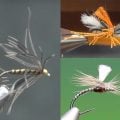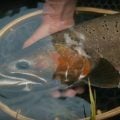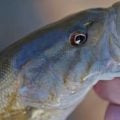Smelting Perfect
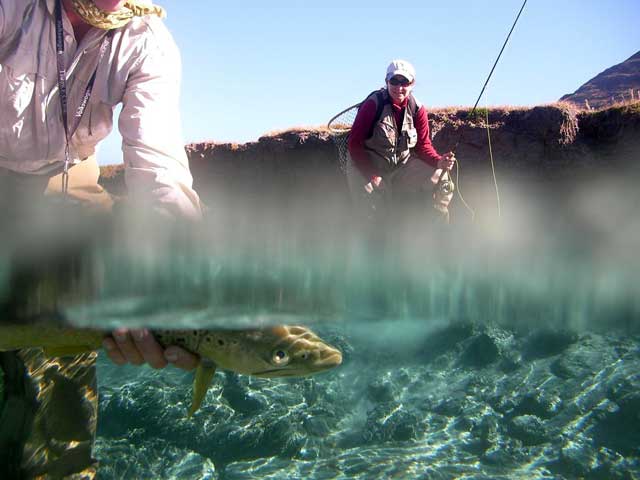 The Southern Lakes of New Zealand always surprise no matter how often you fish them. Maybe it’s their sheer volume and depth that assure we never quite plumb all their secrets, or perhaps the angling discoveries have to be made one at a time, drip-feeding the lifetime of passion. I have lived and fished here for over a decade and a half and I can’t say I really know fishing at the lakes. I do know fragments – some of them quite well – the early-spring nymphing, the manuka beetle bonanza, the cicada time when big browns patrol the surface of the deep-green water like something out of Jaws and when a well-tied Yellow Humpy can yield two dozen fish before it starts to unravel. One thing I did learn about this picture that is the Southern Lakes fishing is that when a new fragment appears, getting to know it is going to be a treat. Without exceptions.
The Southern Lakes of New Zealand always surprise no matter how often you fish them. Maybe it’s their sheer volume and depth that assure we never quite plumb all their secrets, or perhaps the angling discoveries have to be made one at a time, drip-feeding the lifetime of passion. I have lived and fished here for over a decade and a half and I can’t say I really know fishing at the lakes. I do know fragments – some of them quite well – the early-spring nymphing, the manuka beetle bonanza, the cicada time when big browns patrol the surface of the deep-green water like something out of Jaws and when a well-tied Yellow Humpy can yield two dozen fish before it starts to unravel. One thing I did learn about this picture that is the Southern Lakes fishing is that when a new fragment appears, getting to know it is going to be a treat. Without exceptions.
This time it was smelting. I used to go all the way to Taupo for a fix of shallow-water fishing to smelting trout and never even thought such sport was possible on my home lakes. Sure, I’ve caught fish on smelt flies here, plying the rips of inflowing rivers during low-water winters but in my ichthyological ignorance I assumed the voracious rainbows were taking the fly for a juvenile brown. Until my compadre Craig Smith enlightened me on the matter.
From March to May there was indeed a smelting season at the Southern Lakes and the fish, both brown and rainbows, were hunting not their own juveniles but land-locked whitebait. Just as the rivers were getting tough to fish, with trout either paired up or extremely educated through a season of harassment, the smelting fish were fresh from the lake. The rainbows especially, living deep and putting on excellent condition (Craig calls them footballs) have only just, or were about to, enter the rivers and may have never seen an angler and an artificial fly. They were confident and aggressive, making for electrifying fishing. Furthermore, Craig said, he knew just the best places to fish for them.
Craig and I started guiding about the same time and, while I gave up to pursue writing novels, Craig went on with his guiding business, developing solid clientele and reputation. But now the guiding season was over and it was time for some Research & Development, which in the lingo of the pros translates into fishing for pleasure.
Thus one perfectly still autumn morning, as the black sand of the beach shaded by a mountain was still frozen, we launched Craig’s Stabicraft on to Lake Hawea and he gunned the motor toward the mouth of the Hunter River. With almost no notice at all, Craig had also invited Georgie Tolmay and it was a masterful call. A Zimbabwe expat and a daughter of an African safari guide, Georgie grew up in the veldt, stopped game hunting at 14 and learnt to fish on the Zambezi tigerfish. Her manners, voice and accent were so unmistakable, when I closed my eyes I could imagine her reading: “I had a farm in Africa at the foot of the Ngong Hills …” The keenest fisher woman we’ve ever met, Georgie was to make our day, both with her enthusiasm and performance, though for now, fluffing up the feathers of our down jackets against the windchill, we did not know any of it yet.
I asked her what was it about fly fishing that could keep a girl so fascinated with it and she said: “When I’m fishing I don’t think of anything else. No business, no responsibilities. My mind and soul are clear and care-free, this is time for me to just be me. And there is so much to learn, it’s a total thrill.” With this particular kind of smelting there would indeed be much to learn, but this we didn’t know either.
Smelting is not a correct term for what we were about to do, though it’s descriptive of the technique, if not of the species. There are no smelt in the Southern Lakes, all efforts to introduce them have failed. What we take for smelt is in fact whitebait, a mix of Galaxiid species, almost the same as the whitebait which streams every spring in from the ocean and which causes an entire tribe of people to abandon whatever they are doing and try to net the little buggers.
Like their ocean-going kin the lake whitebait also migrates upstream to spawn, and likewise, they only make it into the estuaries. There they lay their eggs which, having developed into larvae, are washed downstream so that the life cycle is completed. Trout follow the adult whitebait, eager to top up their condition just before their own spawning runs, and they slash through the sandy shallows, hitting the translucent fingerlings with the ferocity usually reserved for cicadas. It is a sight that shifts the angler’s heartbeat into double-time. At least until he or she starts casting.
There is a definite knack to sight-fishing with a smelt fly, a sensitivity of touch and timing, and getting it just right can be a humbling experience. I won’t be bragging if I say I can put a fly where it needs to be within a cast or two, I also know about the drag and other nuances of presenting a fly. Hell, I used to teach it! So when my turn came to fish I was confident. We sighted a good brown zigzagging its way along the shallow silt shelf. I cast square across the river, plonking the smelt good two metres up and above, sending it on the inevitable collision course with the trout.
So far so easy. The fish saw the fly, it turned and attacked with a burst of speed. A positive take if I ever saw one. I gave it the required 0.4786 second of a delay then lifted the rod ready to yahoo.
Nothing. Just a pile of slack line coiling on itself like a broken guitar string.
The fish returned to its beat, unperturbed, while I untangled. Bad luck? Well, not if it happens four times in a row, on the same trout. Especially if, in identical circumstances, Craig hooked his two fish cleanly, during their first attack. It was clearly a matter of skills. There was finesse and fine-tuning required before those Volts and Amperes could travel up the fly line, into the rod handle and the hand, on to fire the entire nervous system, and make the heart glow.
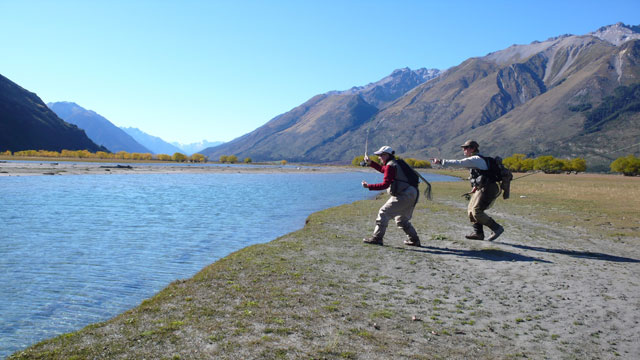 On another fish Craig showed us again. Cast well up and beyond the fish, mend upstream and hold the rod tip down to let the fly sink before it starts to swing. Then, as the fly approaches the fish, give the line a gentle tug. Rising the rod a few inches and pulling in the resultant slack is just enough. Watch the fish chase and take, this is what we’re here for after all. Then, ah, the secret of secrets, a test strip, because in their glutenous rush the trout can often miss the fly just as the inevitable drag whisks it away from in front of their snouts.
On another fish Craig showed us again. Cast well up and beyond the fish, mend upstream and hold the rod tip down to let the fly sink before it starts to swing. Then, as the fly approaches the fish, give the line a gentle tug. Rising the rod a few inches and pulling in the resultant slack is just enough. Watch the fish chase and take, this is what we’re here for after all. Then, ah, the secret of secrets, a test strip, because in their glutenous rush the trout can often miss the fly just as the inevitable drag whisks it away from in front of their snouts.
In my own vocabulary, the test strip would be something a photographic lab would do in pre-digital days, though I guess the term could also refer to a job interview at certain types of night clubs. For Craig, it meant a subtle tightening of the fly line to feel if the fish actually took the fly. If it didn’t, the manoeuvre animated the smelt, adding urgency to its movement and a brutal take would often follow almost instantly.
There are some 19 known species of galaxiid in New Zealand – giant kokopu, koaro, longjawed and flathead, banded and dwarf – but mercifully they can be all imitated with just one fly – the elegantly simple Silicone Smelt. Even on a long leader the Silicone Smelt casts like a dream and you can present it as accurately as you would a dry but the Smelt has one inherent problem you need to keep in mind. Especially on long casts the soft tapered tail has a tendency of catching on the hook and staying on the right angle to it. As you cast and retrieve it, such smelt becomes a veritable propeller putting on a fast-accumulating spin on the leader, making a real mess if you continue unaware.
I have never caught a fish on such “crippled” smelt and it pays to check the fly every few casts. With a bit of experience you can actually hear if the smelt has gone crooked as you cast it. The sound is a light fluttering, not unlike when a dry fly picks up a tiny leaf.
Not all smelt flies are made equal. The cheap round squirts may be okay for the broken water at the rip but fishing to a sighted trout you want unrefusable quality. Such smelts have flattened tails which, Craig insists, assure the all-important trout-triggering flutter when they swim cross-current.
As the day unfolded we stalked the braids of the Hunter, the estuarine oxbows and channels cut into the valley floor flat like a football field. We hooked more fish and lost some too because the hooks of the Silicone Smelt are large and don’t always set well. This we did not mind, being connected to a charging fish even for a few moments was electrifying enough.
The fish were good, averaging around five pounds in weight, and about as much in horsepower. There was only one thing which was ruining this otherwise perfect day: it was late afternoon and Georgie still did not have a fish.
This was not through the lack of trying. Her casting was letting her down a little, especially when a trout was in sight and the adrenalin surging. The fact that speed of delivery was critical – these trout were fast cruisers and you’d often have to run and cast to keep putting the fly in front of their noses – was not making it easy for her. But we worked on her casting, offering hints here and there, and saw that it was changing fast, straightening and getting longer, and more and more perfectly accurate, at least once the fish was spooked.
But then it was too late. The sun had disappeared behind the mountains, and with polaroiding gone and the temperatures plummeting we had to beat a quick retreat for the boat and the open water. Minutes later, we were back in the sun, with the warmth and light streaming in through a deep V-shaped gap in the mountains, aligned like a gun sight with the mouth of the Dingle Burn. We parked the boat and ran toward the braided rips, wanting to make the most of the waning day. And a good thing we did.
With two consecutive casts, and with the current straightening the line and helping her to feel the takes, Georgie hooked two fat rainbows, which – hats off gentlemen – proved to be the largest fish of the day. Both were silver torpedoes smudged with crimson and, as she was only using a # 5 rod, Georgie screamed and cursed in elegant Italian as her forearms were turning into jelly against the sheer pulling power of such magnificent trout.
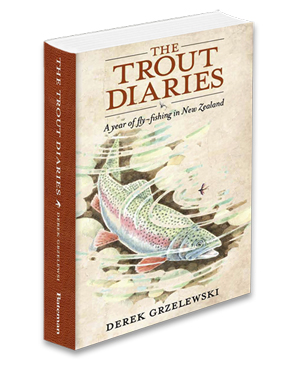 An hour later, we were at Craig’s place overlooking Lake Hawea, watching the expanse of water being swallowed by the dusk. The log fire raged quietly and sitting around it we sipped Glenfidditch, to celebrate the perfect day, to dispel the last of the chill from the journey back.
An hour later, we were at Craig’s place overlooking Lake Hawea, watching the expanse of water being swallowed by the dusk. The log fire raged quietly and sitting around it we sipped Glenfidditch, to celebrate the perfect day, to dispel the last of the chill from the journey back.
In retrospective mood such moments bring about, I casually mentioned how amazing our lakes were, how, just when you thought you knew them well, you’d find something completely new that would both surprise and delight.
“Well, actually, there is another thing you may want to try, not even many locals know about it …” Craig grinned from behind his glass.
What was it? Another one of his secrets? I asked but he would not say.
“Oh go on. Do tell Mr Smith,” Georgie insisted.
“Well, in the spring …” he began, and smiled again.
Georgie and I were all ears.








